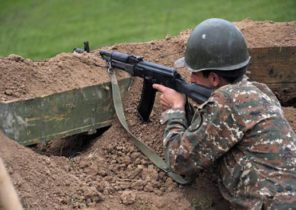
After the annexation of Crimea to Russia on the Peninsula moved at least about 150 thousand people from Moscow, Petersburg, other Russian cities and CIS countries. With up to 150 thousand of the Crimean people moved, mostly to Ukraine. At the end of December 2016 government of the Republic of Crimea adopted the programme for promotion of mass migration to Crimea, mainly from mainland Russia.
According to official data, in 2014 at the end of the third quarter of 2016, the net in-migration to the Crimea amounted to 83 thousand people. In particular, the Peninsula was moved over 149 thousand people, and about 66 thousand people left him. Numbers are based on data from two divisions of Rosstat — Sevastopolskaia, which keeps a record of statistics in Sevastopol, and Cristata, which deals with numbers in the Republic of Crimea (where not part of Sevastopol).
But official data on migration flow does not fully reflect the real migration. The Federal migration service (FMS) takes into account only those who when moving came to the police and filled in the statistical form, as well as those who have registered at the place of residence (registered in apartment). In addition, data on migration in Sevastopol in 2016 are provisional and cover only the period from January to August and during some time in 2014, the government generally did not conduct registration for the Peninsula.
In particular, the actual outflow of the population from the Crimea, apparently, much higher than the official data. Thus, according to Rosstat, on January 1, 2014 the population of the Peninsula was at the level of 2 million 342 thousand 411 people, and by the end of the first three quarters of 2016 was 2 million 337 thousand 406, i.e., the number of Crimean residents decreased by about 5 thousand. Given that the natural population decline due to low birth rates and high mortality during this period was equal to only about 15.5 thousand people, and the net inflow of migrants, according to official data, reached about 83 thousand people, it is unclear why the population has fallen, not increased, and where even the order of 67.5 thousand inhabitants of the Peninsula.
Comprehensive information on this point, but some of the data from different sources indicate that tens of thousands of “missing” left the Crimea, but did not enter the official statistics.
In particular, as mentioned above, according to Rosstat, on January 1, 2014 the population of the Peninsula was recorded at 2 million 342 thousand 411 people. Then check the migration was temporarily stopped, and the results of the census in October 2014 in Crimea, there was already only 2 million 284 thousand 800 people, ie only for the first 9 months of this very turbulent for the Peninsula, the population declined by almost 57 thousand people. Given that natural decline in population (due to low birth rates and high mortality) in that year amounted to only about 5.1 thousand people, and the official migration outflow in 2014, according to Rosstat, amounted to about 8.6 thousand people, it turns out that at least 43 thousand departures were not recorded in official statistics.
Further, according to the British newspaper Telegraph with a reference to the statistics of the State border service of Ukraine, for the period 1 January 2015 to April 2016, the balance of migration between the Crimea and adjacent controlled Ukraine territories amounted to 73 thousand 100 people in favor of the latter (i.e., so many people left the Crimea and did not return).
In other words, the real migration from the Crimea could be instead of the official 66 thousand at least 130 thousand, and more likely closer to 150 thousand, given that mentioned in the preceding two paragraphs, the data on outflow do not cover a few months in 2014 and 2016 (the figures for these months was roughly estimated based on the average and trends for the periods for which data are available).
Given the inconsistencies with the outflow, we can assume that the official discourse on migration inflows are also low. In particular, the statement on the migratory account for citizens of Russia is carried out not in FMS (as in the case of foreigners) and the local police Department. But many do not fulfill this requirement, because distrust of law enforcement and go to the police only in cases of extreme necessity, the more that the penalty for failure to register after moving and living without a residence permit are small (2-3 thousand rubles). EurasiaNet known dozens of people who have moved to Crimea from the continental part of Russia, and none of them stood on the account. Accordingly, these people do not fall in migration statistics, and because the Russians provide most of the migration inflow to the Peninsula, the problems with their account greatly distorts the official figures.
It should be noted that although the total number of inhabitants of the Peninsula to the end of the third quarter of 2016 was nearly the same as at the beginning of 2014, during this period significantly changed the composition of the population, because, according to both official and independent sources, the majority of the migrants came from Russia, and most of the departing went to the Ukraine.
So, according to available aggregate data Cristata and Sevastopolskaia, most of the influx of population accounted for “interregional” migration from the continental part of Russia.
Supported by data from the state statistics and information from non-governmental sources. As told EurasiaNet.org in the real estate Agency Alliance De Luxe (works all over the Crimea), most buyers of expensive houses, apartments and plots on the Peninsula come from the large cities of Russia — Moscow, Petersburg, Rostov-on-don. Cheaper property (up to 2 million rubles) to buy residents of the Moscow region, a small Russian cities, as well as Azerbaijan, Armenia and other CIS countries. According to the Agency, customers from Ukraine over the past 2.5 years had not met, from Belarus — too.
“About 80% of buyers taking housing economy class on the secondary market. New housing take few, because of new buildings on the Peninsula a bit. In Crimea, besides a total of four construction companies, which agreed with the banks about the results their clients mortgages. About 60% of buyers taking housing to move to the Crimea, another 30% as investing money in the hope that the apartments will rise in price in a few years. And only 10% are buying property as a garden or place for a summer vacation,” — said the representative of the Agency.
Many of those who moved to the Crimea on the working circumstances. For example, in December the Director of public relations of the airport of Simferopol was Igor Laptev, who had previously worked as the press service of the airport of Pulkovo (St.-Petersburg). In September 2014 moved to Crimea, the Director of the ring road of St. Petersburg Vyacheslav Petushenko, leading the local Department of transportation (through the year he really left the place). Also many famous people in Russia are in the Crimea Villa. For example, the Director of news Agency “Russia today” (Moscow) and one of the main promoters in the country, Dmitry Kiselev, who recently began producing in the Crimea wine. On the Peninsula a lot of real estate owned by famous people from show business and representatives of creative professions (singer Sofia Rotaru, singer Willy Tokarev, TV presenter Leonid Yakubovich and others), but most were giving on the Peninsula before 2014.
According to the representative of the Agency Alliance De Luxe, among the sellers a large number of people in the Ukraine got the land (for example, under individual housing construction) on favorable terms, and later it was privatized. The bulk of sellers in recent years is the Crimeans who have moved to Ukraine and citizens of Ukraine, who had in Crimea housing, said EurasiaNet.org in the real estate Agency “Dobromir”.
The authorities intend to achieve in the coming years, significant growth of the population of Crimea, mostly due to migration. So, according to the state Council of the Republic of Crimea at the end of December 2016, the law on the strategy of social-economic development until 2030, it is expected that the population of Kazakhstan will only increase by 2030 to nearly 2.4 million., mainly due to the “migration growth”.
However, the forecasts from local offices of Rosstat a little more conservative. So, according to the calculations Cristata, the net inflow of migrants into the country annually will be 18-20 thousand people until 2030. According to the forecast Sevastopolskaia, the annual inflow of migrants will decline from 15.2 thousand in 2016 to 10.5 thousand in 2023-m. By 2030 it will fall to 7.7 thousand people. The population of Kazakhstan by 2030 is expected to grow to 2 million 94 thousand 542 people, Sevastopol — 430 30 thousand to 551 thousand 835 people. The total population of Crimea, thus, in 2030 will reach 2 million 646 thousand 377 people, which is 14% more than in January 2016 (2 million 323 thousand 369 people).
But to achieve these objectives, the authorities will have to work hard. EurasiaNet.org there are instances where residents of large Russian cities refused to move to the Crimea because of poor infrastructure and low level of wages at relatively high prices. In particular, the inhabitant of Petersburg Catherine H in December once again arrived in Sevastopol to investigate, but decided not to move. “The city looks dreary in the winter, on roads full of chaos, — strange, — the narrow streets, on the roadway, all the cars crowded. About salary have heard a local complain. Who didn’t say Peter, they say, Oh! We do dream to Peter to move. When you look at the bulk of the local, see the poverty of some kind. And generally, guys are simple and some wild. In General, something perehotelos me. I think it is better Sochi”, — she told EurasiaNet.org.







